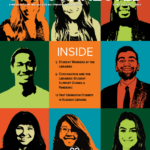Listen to the podcast and read the abridged version.
ALLEN: Hi, you’re listening to Let’s Talk Equity, a podcast by the Colorado State University Libraries. Let’s Talk Equity brings together CSU students and librarians to talk about equity issues and solutions at Colorado State University. I’m your host, Jenna Allen. Today we’re talking about textbooks. We’re asking, What are the student attitudes and challenges related to textbooks? Why are textbooks an equity issue? And how can we make textbooks more equitable and useful? To answer these questions, let’s turn to the experts at CSU.
BUDKE: Hello, my name is Sydney Budke. I am a Sophomore. I’m studying biomedical sciences, and this year I’m serving as the Deputy Director of Academics through ASCSU, and in that position I work very heavily as a student liaison between faculty and students, really bringing to light what students are saying. Because a lot of times it’s hard for faculty to really gauge how the students are talking so I can take those issues and bring them to faculty and really bring them to light and see change.
PAWLIUK: And I’m Christine Pawliuk. I am the business librarian here at CSU, but I do a lot of work with our open educational resources program, which we’ll talk a little bit more about later. But it’s heavily related to textbook costs here at CSU.
ALLEN: What are some of the current student attitudes and challenges related to textbooks and what are they hearing from their instructors about this?
BUDKE: Yeah, so students. Are really just wanting to see their textbooks go into use. So a lot of students feel that some of their textbooks are being overused and some students feel that they’re being underused, so there’s a lot of under representation of how this textbook usage is like directly impacting cost of what students are paying for their textbooks. I know a lot of friends that have shelled out thousands of dollars on textbooks to not touch them in a semester. And this is money that can go towards rent, food, groceries, utilities. So many different things rather than just sitting on a shelf in their room, collecting dust. I think textbooks to students are valuable when they can see a direct impact by what they’re reading in a textbook and how their grade is doing and how that textbook is applying to the actual content of the course. A lot of textbooks that are required aren’t necessarily used, or the professors will take their notes directly from the textbook and lecture on that. So it kind of defeats the purpose of doing your own textbook reading, if you’re going to get it broken down by a professor anyway.
ALLEN: That’s really helpful. Thanks for that context, Sidney. Do you… What are the conversations that are happening between students and instructors about textbooks?
BUDKE: It really just depends on your instructor and your course. Some professors are very open to addressing the costs of the textbooks that they are assigning, and letting students know that if they are having issues with the cost of the textbooks—because they do add up very quickly—to go to them and they will figure out a solution. In my personal experience, I have not had very many of those conversations with professors. It almost seems like professors have this idea that this is the textbook that they want and so the cost doesn’t really matter to them. And because you want to be a student in learning, you will do what you need to to get that textbook. So it’s really just a toss–up on whether or not the professor is willing to listen and acknowledge how much their textbooks are costing.
PAWLIUK: I’m gonna throw this question in here because it’s something that I’ve seen in surveys. What, in your perspective, Sydney, what have you heard that students do if they can afford a textbook? Does that make sense?
BUDKE: Yes, that’s a great question. I have heard a couple of different variations of things. Some students will genuinely just wing the class if they can’t afford a textbook. They will just not do the readings, not put what they need to into the class, just because they can’t afford that, so they will do everything in their power to like learn that information without getting the textbook. Sometimes they will borrow from friends if they can’t afford it. I’ve also heard of students where the homework comes from the textbook. If they can’t afford the textbook access code, some of them have free trials and I have heard of students completing an entire class in like a two–week free trial period without any instruction, and just really just going for it because they’re not willing to shell out money when they can’t, just for a class.
ALLEN: So the next question is how does this all relate to equity and why are textbooks an equity issue?
PAWLIUK: Yeah, I will handle that one. So from kind of the non–student perspective, I guess more the faculty or library perspective. The way we, or I kind of see it through the lens of affordability. I mean really so that. That’s kind of why I just asked the question of Sydney. Like, I wanted to hear a little bit more about what it is actually like for students at CSU. And just to hear that somebody is trying to do a whole class through a trial period is… I had not heard that before. That is a little shocking to me, honestly. But really, we’re care what we care about is making the University or University education more affordable for students here. And I’ll say one of one of the ways that we talk about it most in the library, since because we don’t actually teach credit courses, but we can still advocate to faculty for ways to reduce the cost of their textbooks. One of the big things that we do, we is that we’re pushing more knowledge of open educational resources towards faculty. And these are really just, they’re basically openly licensed textbooks, which means that anybody on the Internet can freely share them or distribute them there. Textbooks that are free to use basically, usually they’re written by faculty at other institutions, although we do have some faculty here at CSU who are creating textbooks to be used for free for students. Just to help make things a little bit more affordable for them.
BUDKE: Um, so with these open educational resources, is the quality of the textbook going to be the same as some of these textbooks that you would normally pay for? And are you getting the same information in the free textbooks that you would be getting with a paid textbook?
PAWLIUK: The short, I mean the real answer is it depends. But in general, yes, it’s gonna be the same quality, because the person who’s choosing it is really the faculty member who’s teaching the course. And they can decide if they don’t think that the textbook, the open textbook, is good enough for their course, then we tell them they shouldn’t assign it. Um, quality is still important. I think it goes back too to what you said about does the textbook, like, impact the students’ grades positively. Like, do they need it? Is it giving them kind of a value added in the course to help their grades, to help them academically? So that’s kind of related to the quality a little bit. But in general, like, especially the ones that are created with University support, they’re created by other experts in the discipline. So they follow generally the same outlines and they’re pretty good quality, I think, for the most part.
ALLEN: Christine, to follow up on that are there… is there any research or are there any studies that have been done related to the things that you’re talking about in terms of like student success and textbook costs and open educational resources and that impact? Like what, what’s the research there?
PAWLIUK: Yeah, so there is. Open educational resources is a pretty newish concept in higher education, but there are a few studies. So one study came out of the University of Georgia, where they compared basically different sections of a course. Some of which were using OER, er, using open textbooks, and some of which were not using open textbooks. They’re using the traditional ones. And they actually saw in the courses that were using open textbooks, student grades actually went up by 8%—8.6% to be exact about it. Which is almost an entire letter grade. And what’s really interesting about that study in particular, too, is that they broke out the students between, they actually broke out Pell–eligible students, which if you’re not familiar a Pell Grant is basically, it’s extra assistance that’s given to economically disadvantaged students. So in this particular study, the Pell–eligible students actually saw a 12.3% increase in their grade when they were using open textbooks, which is more than a letter grade. So that suggests that there is a really big academic impact in using these open textbooks, especially for students who are a little bit more disadvantaged.
ALLEN: To build on that, you know, if we know that affordability of textbooks is an equity issue, and we know that open educational resources might be a solution to that, what are we doing right now at CSU in terms of programs or initiatives?
PAWLIUK: Yeah, so we, for the past couple of years, the Libraries have received a grant from the Colorado Department of Higher Education to help promote open resources here at CSU. So I’ve personally put on a few workshops for faculty to teach them OER is, and we’ve invited a panel of faculty, too, to actually, who have been using open educational resources in their classes to talk to other faculty about what it’s like, how they implemented it. Maybe even what the student response has been. And we’ve also given out some grants to faculty in order to develop open textbooks or just adapt some existing textbook into their course. We actually have, where is it, one of our grant recipients named Medora Huseby. She’s in the Microbiology, Immunology and Pathology Department here at CSU. And she actually has been really involved in creating open textbooks. She is working on one in her courses right now where the students are actually helping to develop it and edit it and keep it current, so it’s a really cool project. She actually, just a couple months ago, won a Governor’s award for Best Open Course, which was really exciting for her and for us.
BUDKE: What is CSU as a whole, and more specifically, kind of the bookstore-side of things, doing to bring in low textbooks costs for the students?
PAWLIUK: Yeah, so one of the things that the bookstore has been doing… We’ve been working with them to, first of all, identify courses that do have low textbook costs. But also to get that information into the course registration system, so that students know when they’re registering for a course which courses are going to have those low textbook costs. Just so the students can better plan their semester. So like if you’re in, if you know you’re in a STEM heavy program that has pretty high textbook costs, you can maybe look at electives that have a little bit lower cost to help manage your costs that way.
ALLEN: Let’s wrap it up with a couple of takeaways. So Sydney, what’s, what do you think the takeaway is for students? What do you think students can do to help address, you know, these challenges of textbook affordability.
BUDKE: I think the biggest thing that students can do is just bringing to light this issue. I think with students it’s just kind of assumed that because you’re in college, you should be spending a lot of money on textbooks, and that’s just the expectation going into school. And so it kind of gets brushed under the rug because it’s just expected at this point, but other faculty members don’t really see these small, like, student issues. If all these students are rising up with the same common interest, it might be able to bring change from it, and especially with how we have advanced, just as a society, I don’t think that spending all this money on physical textbooks is necessary anymore. I think there’s definitely ways that this could be reduced. Another big thing is just talking to ASCSU—getting involved with ASCSU. That is what we’re here for, is to take these student issues and really bring them to light because as students we do have the power to see change at this University, which is a really cool thing, but not a lot of people know that that is really an option for you as a student. So really just making your voice heard and having those conversations with your professors and talking to students that you know are involved in ASCSU and just things like that.
ALLEN: Christine, what about libraries? What do you think the Libraries can do or keep doing?
PAWLIUK: Yeah, so I think we’re definitely going to be continuing our work with faculty to get more OER use in their courses. There’s also some other partners on campus that we’re going to be working with. We have been working with some instructional designers in the Institute for Learning and Teaching, which helps faculty with designing new courses or revamping their courses. That’s been a really important partner for us as well. But really, I think also what we can do is just, work with these student groups that are going to be working on advocacy. I think it would be really important for them to know that we see them too like we see this issue and there are people on campus who do want to help them.
ALLEN: So thank you so much time, Sydney and Christine. I really appreciated the expertise that you brought to this conversation and thanks to our listeners. So take care.




